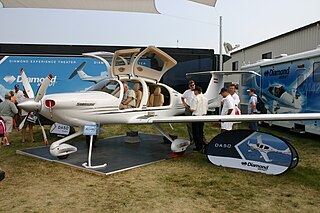
The Cessna 208 Caravan is a utility aircraft produced by Cessna. The project was commenced on November 20, 1981, and the prototype first flew on December 9, 1982. The production model was certified by the FAA in October 1984 and its Cargomaster freighter variant was developed for FedEx. The 4 ft (1.2 m) longer 208B Super Cargomaster first flew in 1986 and was developed into the passenger 208B Grand Caravan.

Harbour Air Seaplanes is a scheduled floatplane service, tour and charter airline based in Richmond, British Columbia, Canada. The predominantly seaplane airline specializes in routes between Vancouver, Nanaimo, Victoria, Sechelt, Comox, Whistler and the Gulf Islands, primarily with de Havilland Canada floatplanes. Harbour Air operates de Havilland Beavers, Otters and Twin Otters.

The Cessna 180 Skywagon is a four- or six-seat, fixed conventional gear general aviation airplane which was produced between 1953 and 1981. Though the design is no longer in production, many of these aircraft are still in use as personal aircraft and in utility roles such as bush flying.

The PAC P-750 XSTOL, is a utility aircraft of conventional all-metal low-wing monoplane design, with fixed tricycle undercarriage. Combining the engine and wings of the PAC Cresco with a new large fuselage and modified tail, all versions to date have been powered by a 750 hp (560 kW) Pratt & Whitney Canada PT6 turboprop. It is designed and manufactured in Hamilton, New Zealand by Pacific Aerospace Limited.

The aircraft diesel engine or aero diesel is a diesel-powered aircraft engine. They were used in airships and tried in aircraft in the late 1920s and 1930s, but were never widely adopted until recently. Their main advantages are their excellent specific fuel consumption, the reduced flammability and somewhat higher density of their fuel, but these have been outweighed by a combination of inherent disadvantages compared to gasoline-fueled or turboprop engines. The ever-rising cost of avgas and doubts about its future availability have spurred a resurgence in aircraft diesel engine production in the early 2010s.

An electric aircraft is an aircraft powered by electricity. Electric aircraft are seen as a way to reduce the environmental effects of aviation, providing zero emissions and quieter flights. Electricity may be supplied by a variety of methods, the most common being batteries. Most have electric motors driving propellers or turbines.

The Diamond DA50 is a five seat, single-engine, composite aircraft designed and built by Diamond Aircraft Industries. First shown in 2006, it made its maiden flight on 4 April 2007. The project has been proposed to be powered by several different engines, but was certified on 9 September 2020 with the Continental CD-300 diesel.

The Pipistrel Panthera is a lightweight, all-composite, highly efficient four-seat aircraft under development by Pipistrel of Slovenia.

The RED A03 is a V12 four-stroke aircraft diesel engine designed and built by RED Aircraft GmbH of Adenau, Germany.

The Bye Aerospace eFlyer 2 is a light electric aircraft designed and under development by Bye Aerospace of Denver, Colorado.

The NASA X-57 Maxwell was an experimental aircraft being developed by NASA, intended to demonstrate technology to reduce fuel use, emissions, and noise. The first flight of the X-57 was scheduled to take place in 2023, but the program was cancelled due to problems with the propulsion system.

The Eviation Alice is an electric aircraft designed to accommodate nine passengers and two crew members. First developed in Israel, its construction incorporates 95% composite material, is powered by two electric motors, and has a T-tail. The prototype first flew on 27 September 2022.

Wright Electric is an American startup company developing an electric airliner.
The Airbus/Rolls-Royce/Siemens E-Fan X was a hybrid electric aircraft demonstrator being developed by a partnership of Airbus, Rolls-Royce plc and Siemens. Announced on 28 November 2017, it followed previous electric flight demonstrators towards sustainable transport for the European Commission’s Flightpath 2050 Vision. A BAe 146 flying testbed was to have one of its four Lycoming ALF502 turbofans replaced by a Siemens 2 MW (2,700 hp) electric motor, adapted by Rolls-Royce and powered by its AE2100 turboshaft, controlled and integrated by Airbus with a 2 t (4,400 lb) battery. In April 2020, the programme was cancelled during the COVID-19 pandemic.

The Rolls-Royce ACCEL is an electric aircraft demonstrator developed by Rolls-Royce plc.

The VoltAero Cassio is a family of hybrid electric aircraft being developed by startup company VoltAero. The company plans to produce three configurations of the Cassio aircraft: the four-place Cassio 330, the six-place Cassio 480, and the ten-place Cassio 600.
A hybrid electric aircraft is an aircraft with a hybrid electric powertrain. As the energy density of lithium-ion batteries is much lower than aviation fuel, a hybrid electric powertrain may effectively increase flight range compared to pure electric aircraft. By May 2018, there were over 30 hybrid electric aircraft projects, and short-haul hybrid-electric airliners were envisioned from 2032.
The Ampaire Electric EEL is a hybrid electric aircraft developed by U.S. startup Ampaire, established in Hawthorne, California. The forward piston engine of a Cessna 337 Skymaster is replaced by an electric motor powered by a battery, in a parallel hybrid configuration. The demonstrator first flew on 6 June 2019.

The Scylax E10 is a 10-seat all-electric aircraft project by German start-up Scylax Aircraft.
The Safran EngineUS is a family of electric motors for aircraft propulsion developed by Safran, outputting up to 500 kW (670 hp).
















